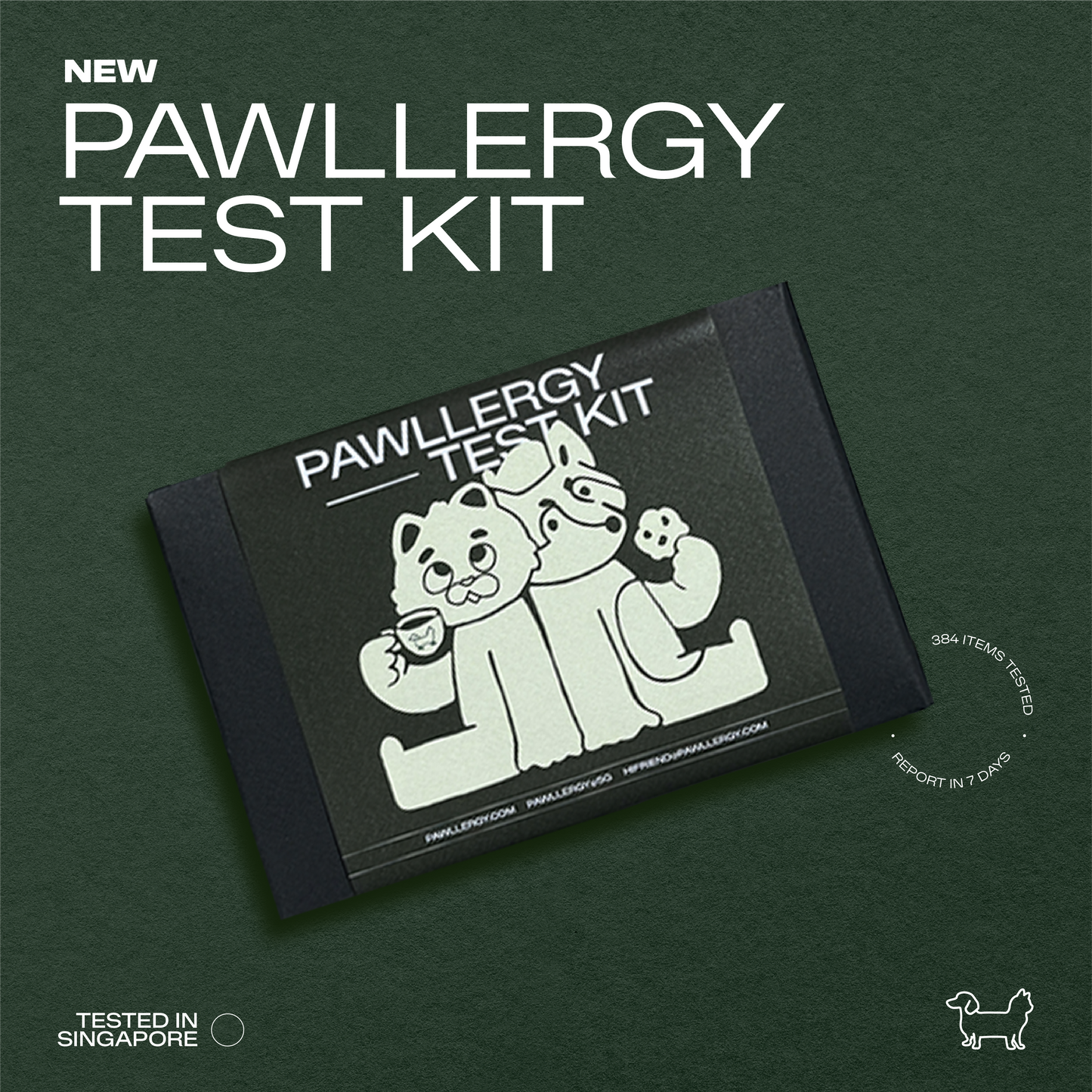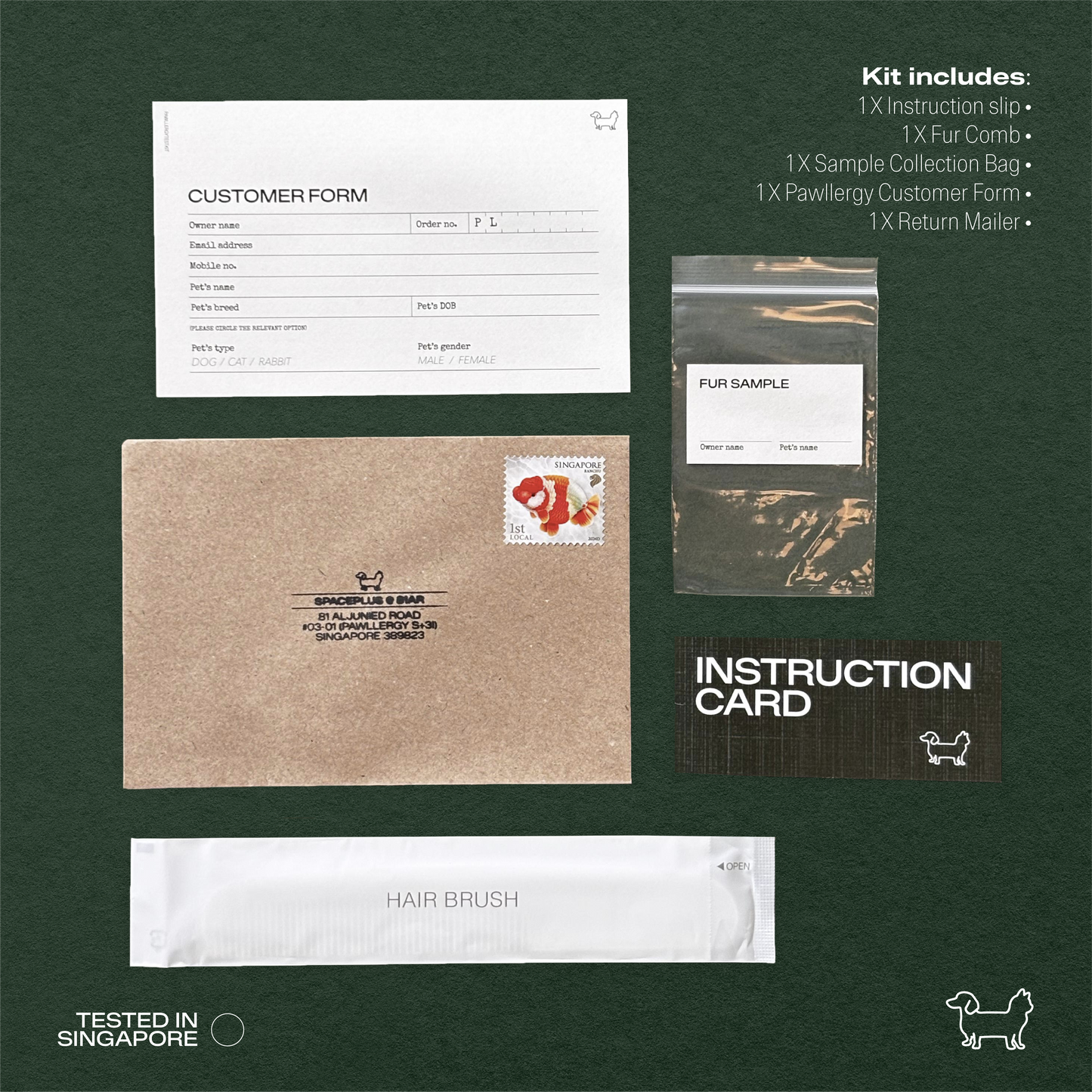Understanding Your Report
Your pawllergy report designed to be a guideline and not a diagnosis. Start your food elimination journey with your furry friend!
Utilize our pawllergy report as a starting point for understanding your pet's dietary needs.
About Bioresonance Testing
Pawllergy uses non-invasive bioresonance testing to detect potential sensitivities in your pet. This includes food items, environmental factors, and nutritional imbalances — all based on a small fur sample. The process is painless, stress-free, and can help guide lasting changes to support your pet’s overall well-being.
Collapsible content
Principle of Bioresonance Technology
Bioresonance is grounded in the idea that the body's cells communicate through electromagnetic signals.
When your furkid is intolerant or sensitive to a particular substance, it is believed that this disrupts the body's natural electromagnetic field.
Testing Process
The collected sample is exposed to a range of electromagnetic frequencies corresponding to different foods and non-food items.
The bioresonance device then measures the body's response to each frequency.
Analysis
If the body exhibits a stressed or negative response to certain frequencies,
it indicates a potential intolerance or sensitivity to the corresponding substance.
The results are then compiled to identify which foods or items may be causing adverse reactions.
Benefits of Bioresonance Technology
Bioresonance testing is non-invasive, painless, and can test for a wide
range of sensitivities in a single session.
It can be particularly useful for
pets experiencing unexplained symptoms that may be linked to
food intolerances.
Understanding your Results
As a wide range of items are tested, the Pawllergy Test report is designed to help you focus on your elimination journey.
To keep things simple, only moderate and high sensitivities are reported. Items with reactions below 85% are not included, as they rarely cause symptoms.
Collapsible content
Results reported
Results will be displayed in the following
Red (High Sensitivity) and Yellow (Moderate Sensitivity) format throughout the report.
High Sensitivity (95%-100%): These are items that testing has returned with a high response.
Moderate Sensitivity (85%-94%): These are items that testing has returned with a borderline response.
Using the Pawllergy Test Report Effectively
The Pawllergy test is designed to help you concentrate on the items that need to be eliminated. We only report items with sensitivities at or above the 85% threshold. To make the most of this report, refer to the glossary at the end. Generally, items not reported are generally safe to feed.
The Pawllergy Test identifies sensitivities or intolerances and is not an allergy diagnosis. It does not detect symptoms associated with allergies, such as anaphylaxis, respiratory distress, rashes, hives, swellings or skin boils.
The Pawllergy test reports on items tested individually. Cross-reactivity between food groups is not covered in this test.
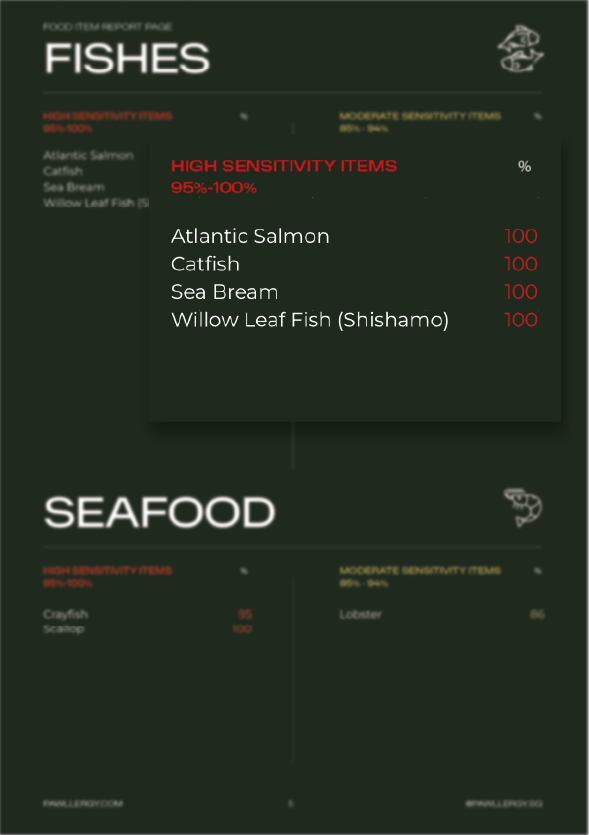
High Sensitivity Foods: A Guide to Understanding and Eliminating Triggers
The foods items reported in this page suggests a high-sensitivity picked up. This means that your pet may exhibit a reaction when exposed to these foods.
This page is your starting point for understanding what foods to avoid to improve your pet’s quality of life. Together, we can help your pet feel their best by identifying and managing their unique sensitivities.
Collapsible content
Elimination of high sensitivity food items
We recommend eliminating this food if any symptoms are observed. Please note that some symptoms may not be immediately noticeable, as the sensitivity might contribute to longer-term health issues internally that have not yet surfaced.
Foods fed regularly may appear in your report
Over-exposure to a single protein in a pet's diet can lead to the development of food intolerance over time.
When a dog consistently consumes the same protein source, their immune system may become sensitised, causing it to react negatively.
To prevent such intolerances, it is crucial to maintain a varied diet that introduces different protein sources, allowing the pet’s immune system to remain balanced and promoting overall health.
Why It’s Important to Start Here
Viewing an extensive list of items in your report can be overwhelming. Therefore, it’s essential to begin with the high-sensitivity section, as the foods listed here are likely responsible for your pet's symptoms.
If your pet continues to experience issues after 3 to 6 months of eliminating these high-sensitivity foods, you can then consider removing items from the moderate sensitivity section.
Intolerances Can Change Over Time
Please note that your pet can develop a food intolerance over time to foods they have been eating regularly
The good news is that food intolerances are not always permanent. Sensitivities can regress with careful management, allowing your pet to enjoy a more varied diet in the future.
By removing high-sensitivity foods from their meals now, you give their system the chance to recover and rebuild tolerance.
Do note that, on the flip side, new intolerances may develop over time as well!
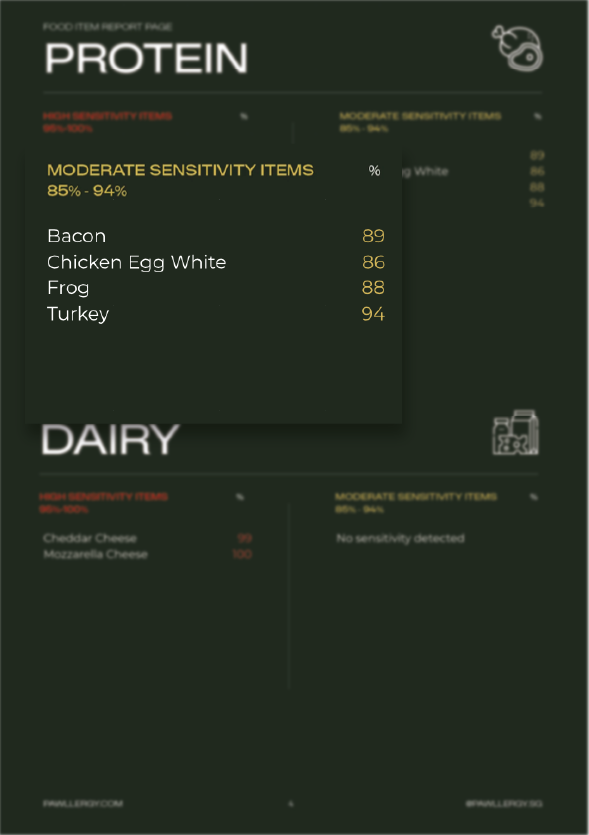
Moderate Sensitivity Foods: A Balanced Approach to Management
The foods listed here are classified as moderate-sensitivity items for your pet. These foods are less likely to trigger immediate or severe reactions but could still contribute to discomfort if consumed in large quantities or too frequently.
Collapsible content
Monitoring and Eliminating Food Items
We recommend monitoring your pet for any symptoms and eliminating the food item if necessary.
If no symptoms arise, you may continue to offer it in moderate amounts and less frequently, such as using it as a treat instead of including it in your pet’s daily diet.
How to Manage Moderate-Sensitivity Foods
Flexible Inclusion: You can continue to include these foods in your pet’s diet as occasional treats or in lower quantities. Moderation is key—avoiding regular or excessive feeding can help minimise any potential adverse effects.
Adjust Frequency: Consider limiting these foods to rare occasions rather than making them a staple in your pet’s meals. This approach allows your pet to enjoy a varied diet without exacerbating sensitivities.
Understanding Food Weightage
Food weight can influence moderate intolerances, as each pet is unique.
For instance, while 5 blueberries may not upset one pet's stomach, they could trigger diarrhea in another.
It’s important to experiment with the foods listed in the moderate sensitivity section to help enhance your pet's quality of life by allowing them to enjoy a diverse diet.
Rather than completely eliminating all foods from this section, consider reintroducing them in small amounts and less frequently.
This approach may help your pet gradually build a tolerance over time.
Striking the Right Balance
Moderate-sensitivity foods provide some flexibility in your pet’s diet but require thoughtful management.
By incorporating these items sparingly, you can continue to provide variety while supporting your pet’s overall health and wellbeing.
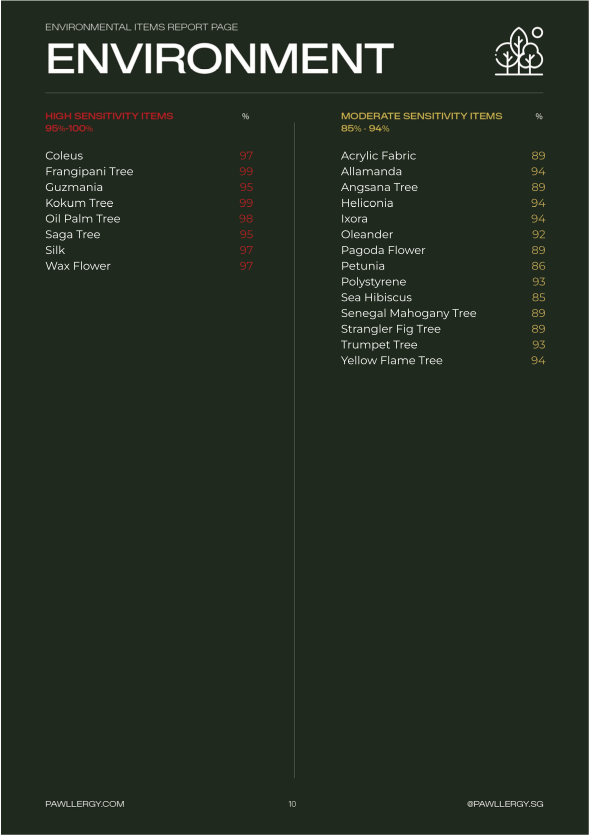
Environmental Sensitivities: Understanding Your Pet’s Triggers
This section highlights your pet's environmental sensitivities, encompassing both high and moderate levels. These sensitivities are managed similarly to food sensitivities, with a focus on reducing exposure and monitoring reactions to create a more comfortable living environment for your pet.
Collapsible content
Practice Avoidance
Since avoiding some environmental triggers may be difficult, we recommend practicing as much avoidance as possible.
Managing Environmental Sensitivities
- High Sensitivity: Items in this category may provoke stronger reactions in your pet. Minimising or completely avoiding exposure to these triggers is recommended to prevent discomfort or exacerbation of symptoms.
- Moderate Sensitivity: While these items may not cause severe reactions, reducing their presence in your pet’s environment can still help improve overall wellbeing. Occasional exposure may be manageable, but it’s best to limit frequency where possible.
Why Reduce Exposure?
Environmental sensitivities can affect your pet’s quality of life, leading to skin irritations, respiratory issues, or behavioural changes.
Overexposure to allergens can amplify symptoms over time, while limiting contact may help their system adjust and reduce adverse reactions.
Building a Healthier Environment
By identifying and managing both high and moderate environmental sensitivities, you can create a space that supports your pet’s comfort and vitality.
Small changes, such as adjusting cleaning products, controlling pollen exposure, or choosing pet-safe materials, can make a significant difference in their daily life.
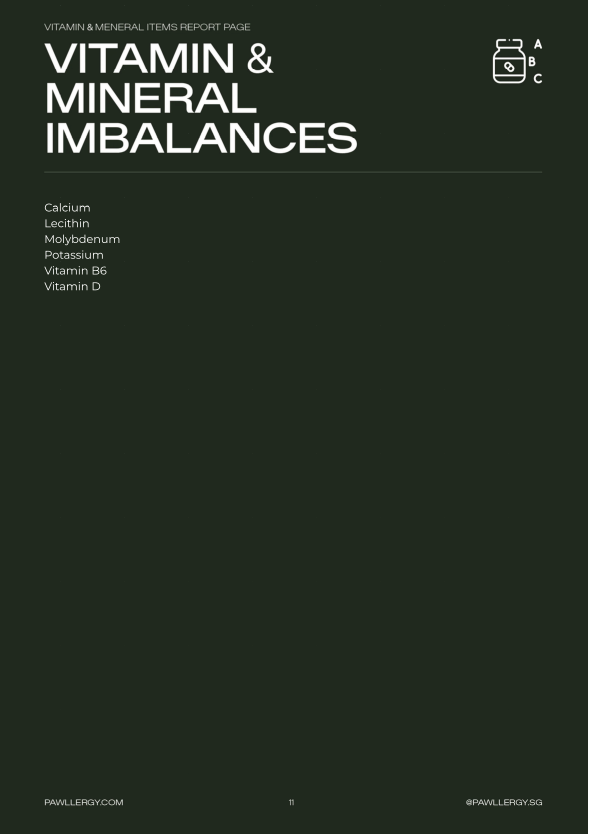
Vitamin and Mineral Imbalances: Supporting Your Pet’s Nutritional Needs
This section focuses on addressing your pet’s unique vitamin and mineral imbalances. Identifying and managing these deficiencies is essential for supporting their overall health and wellbeing.
Collapsible content
How to Use the Glossary
At the end of your Pawllergy report, you’ll find a detailed glossary that provides suggestions for addressing specific vitamin and mineral deficiencies. This resource is designed to guide you in selecting natural food sources to help balance your pet's diet.
- Identify the Deficiency: Review the report to see which vitamins or minerals your pet may be lacking.
- Consult the Glossary: Use the glossary to find natural food sources rich in the required nutrients. For example, if your pet is low in Vitamin A, the glossary will list foods you can incorporate into their diet to boost this nutrient.
- Incorporate Natural Sources: Where possible, choose fresh, whole foods to meet your pet’s nutritional needs. Aim for variety to ensure a balanced diet.
Why This Matters
Vitamin and mineral imbalances can impact your pet’s energy, immune system, and overall health.
By proactively addressing these gaps with targeted nutrition, you can help your pet feel their best and prevent potential health concerns.
Ready to purchase your Pawllergy Kit?
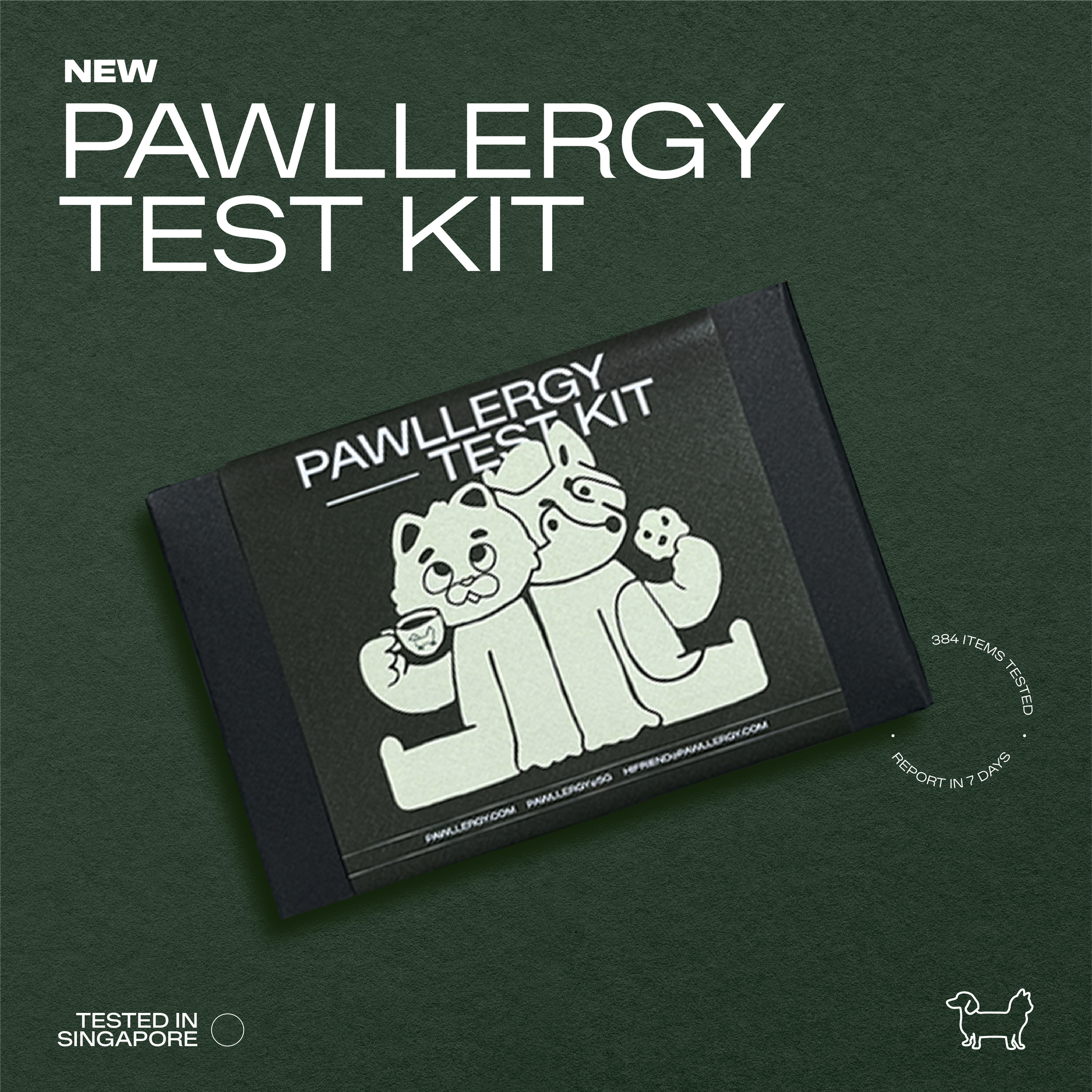
Pawllergy Test
Share
